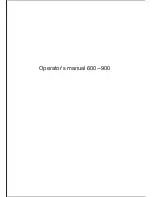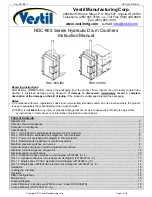
---15---
C. General description
C 2.
Service
In order to function satisfactorily the tractor must be
properly maintained.
The necessary daily lubrication and routine checks, can,
of course, be carried out by the driver.
Where adjustments and repairs are necessary which
require the attention of a qualified mechanic and the use
of special tools, it is advisable to rely on a workshop. In
this case we advice you to consult your local dealer as to
how your tractor should be looked after as he is in a
position to give you the best possible service. Through
service bulletins and special training courses he is kept
constantly informed of the factory’s recommendations
regarding care of the tractor.
C 2.1.
Cost---free service
Before leaving the factory the tractor was thoroughly
tested and adjusted to ensure it is in first-class condition
when delivered to you.
However, it is important that the tractor is given further
checks during the first period of operation. Bolts must be
checked for tightness, various settings inspected and
other minor adjustment made. Your dealer therefore gives
one cost---free service inspection (excluding oil and filter
costs) after 100 hours running.
C 3.
Engine
A C5
The tractors have 4---stroke direct injection diesel engines:
Three---cylinder engine, turbocharged;
---A75n, A75
L
Four---cylinder engine, turbocharged;
---A85n, A95n
Three---cylinder engine, turbocharged and intercoolered;
A85
L
, A95
L
The principle of the turbocharged engine is that exhaust
gases from the engine cylinders drive the turbo unit which
forces air into the cylinders. This means that a higher
power output can be obtained with economical fuel
consumption.
The engine induction air passes through the air filter and a
safety filter inside the air filter. The air intake system has
an effective ejector pre---separator system (4---cylinder
models), most of the impurities are removed before they
reach the filter by the exhaust fume flow. The safety filter
prevents the engine from being damaged if the main filter
fails.
These new 20---series engines have lower fuel
consumption and cleaner exhaust gases.
C 4.
Power transmission
C 4.1.
Clutch
A3565---17
The clutch is of the twin type and is attached to the engine
flywheel. There are separate discs for the propulsion
clutch and power take---off. Both clutches are operated
mechanically independently of each other, the propulsion
clutch being controlled by means of a pedal and the
power take---off clutch with a lever.The clutch plates are
both axel--- and rad springed.
As extra equipment the push buttons for HiShift are
available (not in open cab models), making driving easier
so there is no need to use the foot clutch pedal.
Traditional use of clutch pedal is, however, always
possible.




































